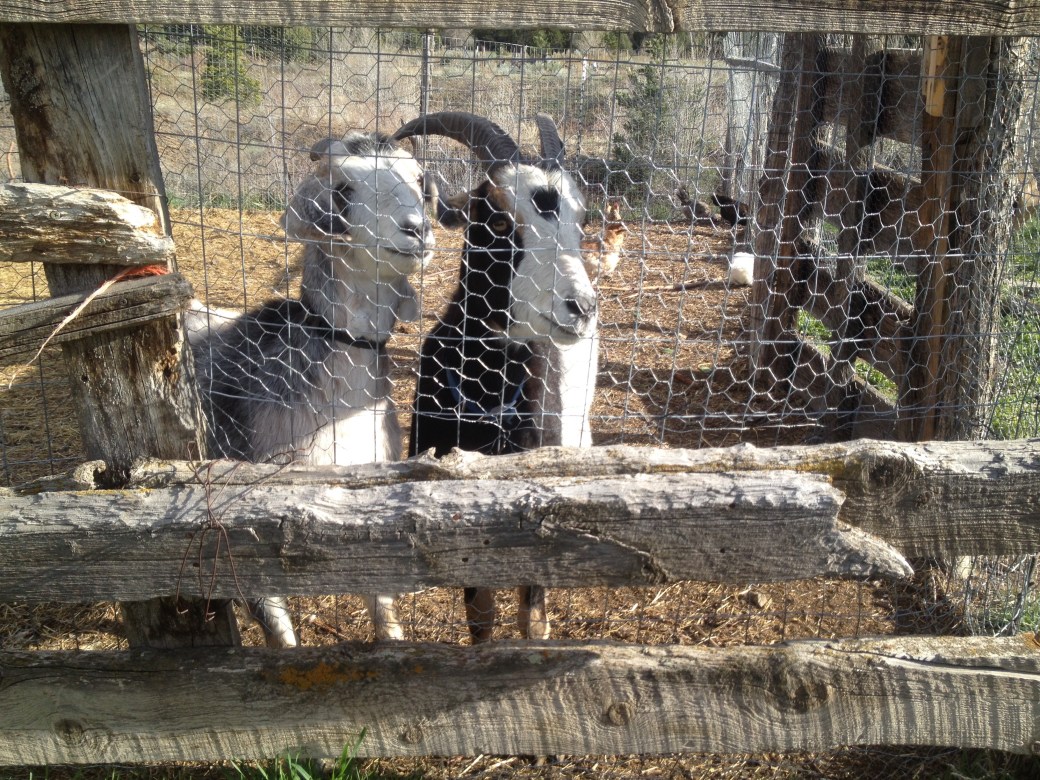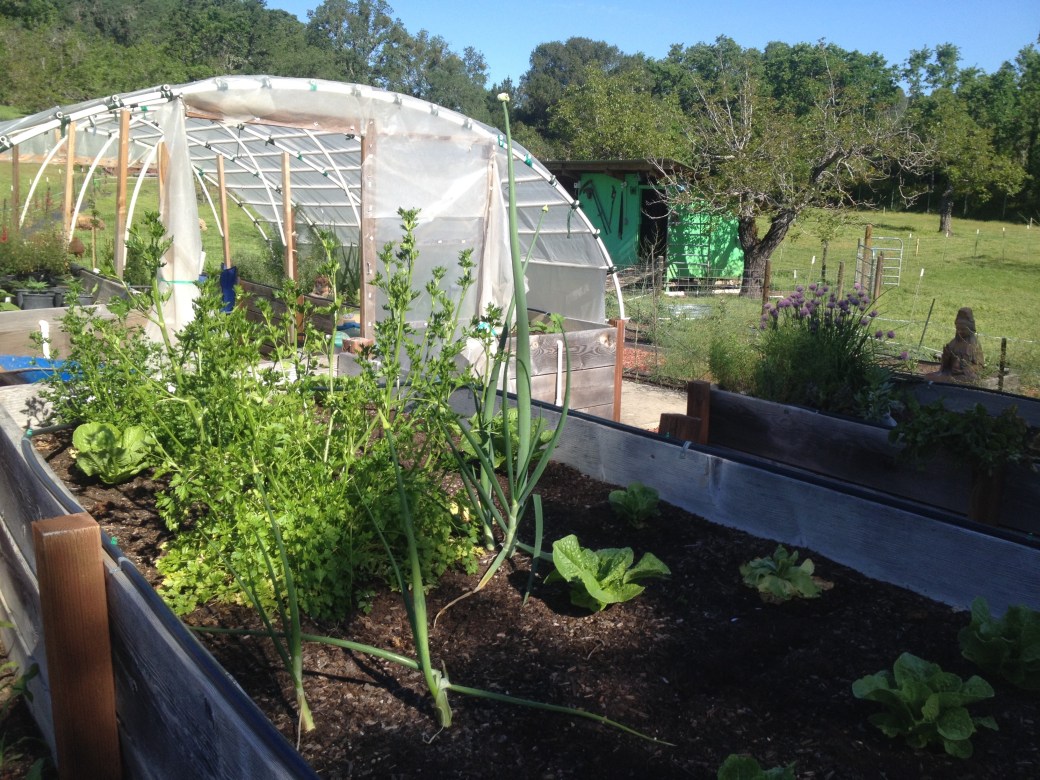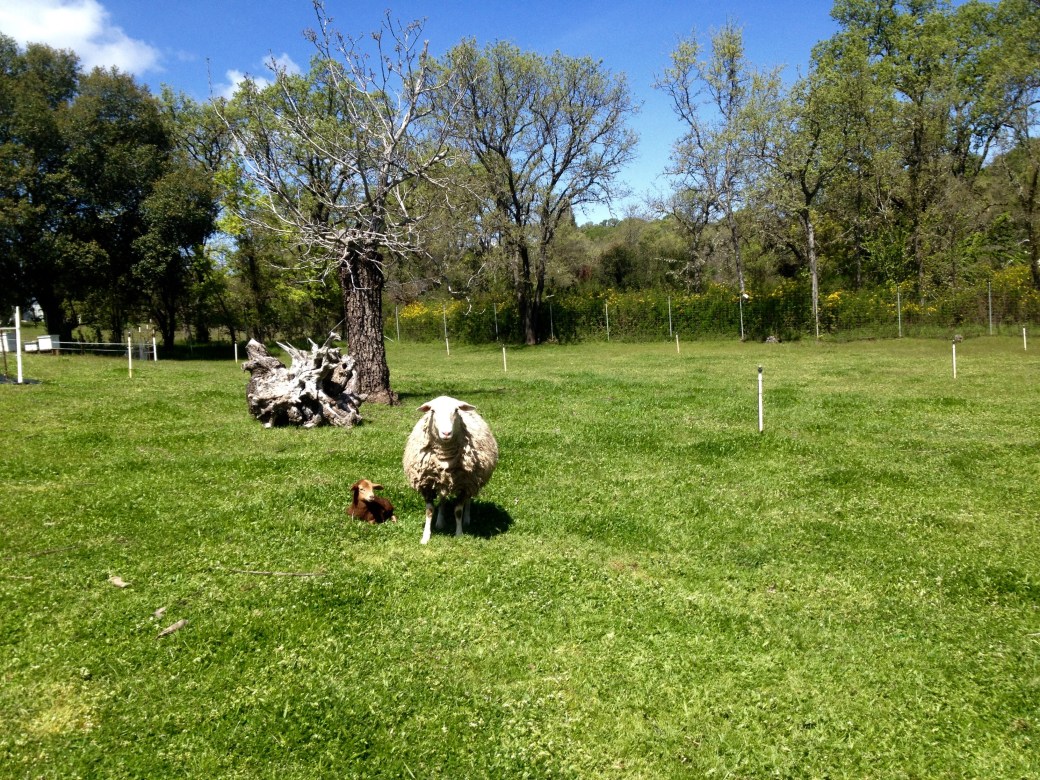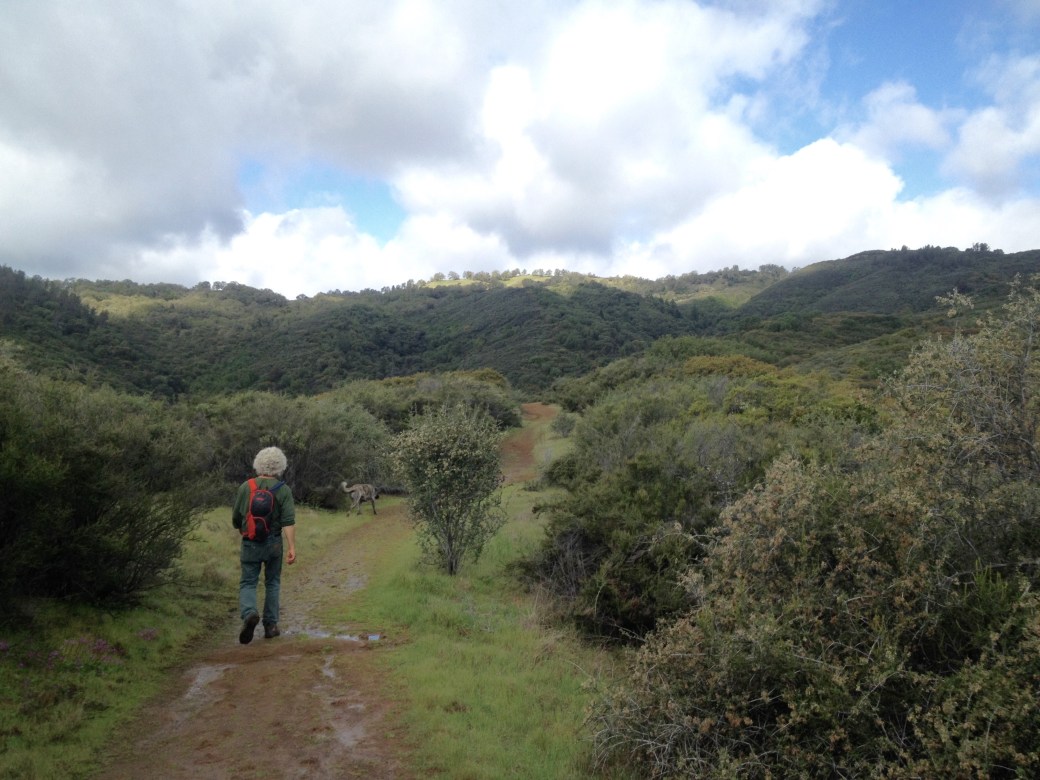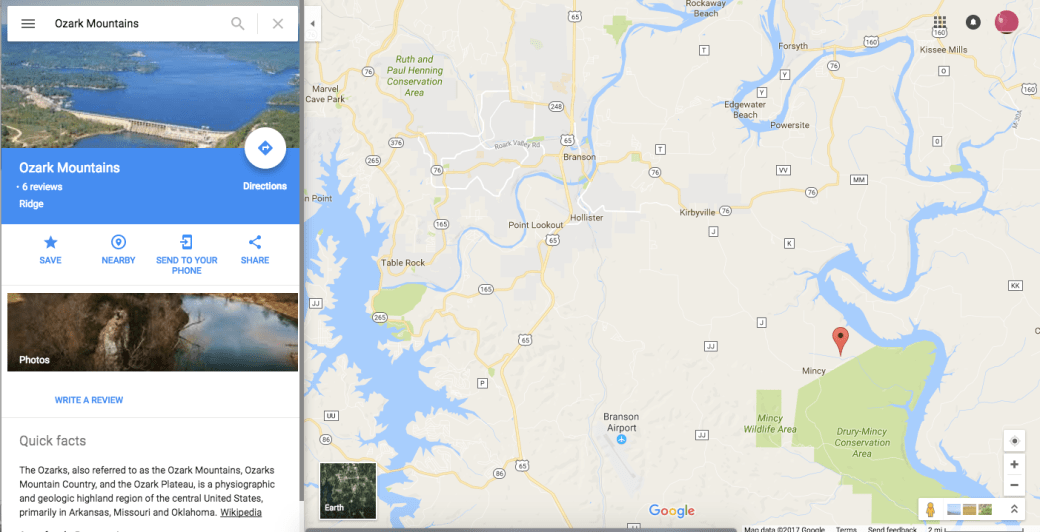This October, María Lionza and I had an opportunity to visit those opposing the Dakota Access pipeline near Cannon Ball, North Dakota. The 1,170-mile pipeline connecting North Dakota’s Bakken and Three Forks production areas to Illinois is expected to transport 470,000 barrels of oil per day, starting as early as the end of this year. Its construction has been highly controversial. Originally slated to cross the Missouri River north of Bismark, it was rerouted partially due to the potential threat to the city’s water supply. Native American groups say that the new route, which will cross the Missouri River near Lake Oahe, threatens the water source for the Standing Rock Sioux Reservation and other tribal groups, and overturns many of their sacred burial sites.
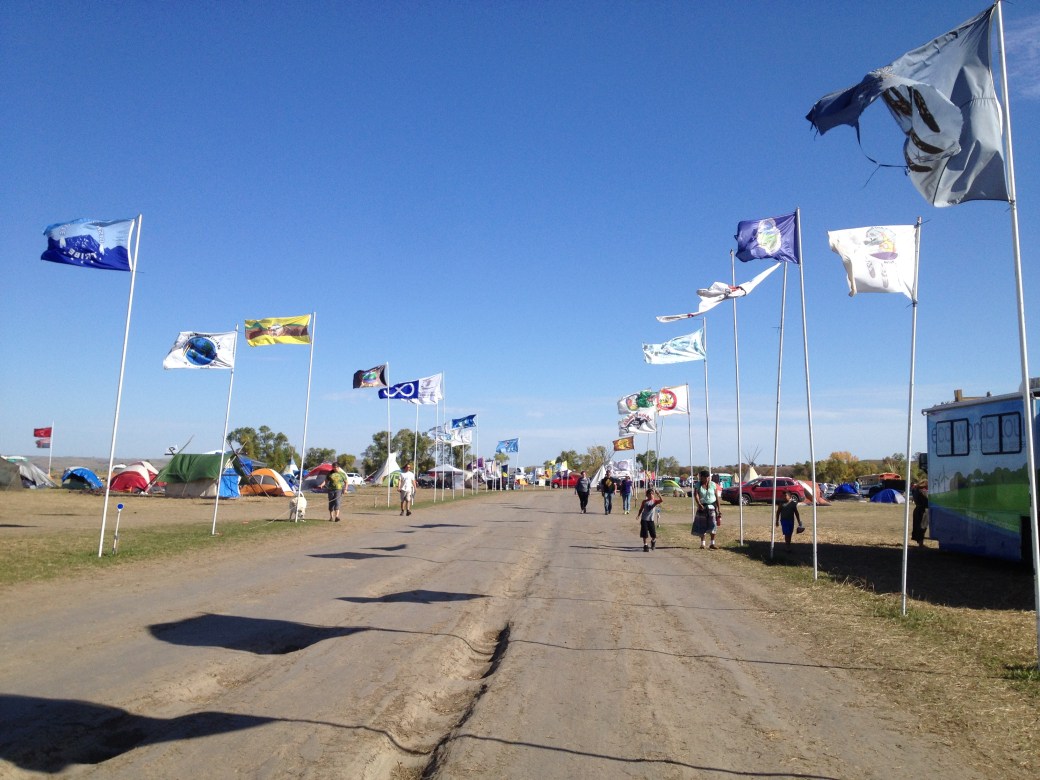
Indigenous flags line the entrance to the camp near Cannon Ball, ND.
Thousands of indigenous people from all over the U.S. – and the world – have since converged at the camp along the Missouri River. While I was there, an aboriginal woman from Australia arrived to present a kangaroo skin and an aboriginal flag, and a group of Mexica (formerly Aztec) people with huge, feathered headdresses performed a dance. One speaker commented on a prophecy that one day, the condor and the eagle would come together. “We are seeing this prophecy fulfilled,” he said.
I spoke to several people at the camp, and asked them two questions: “Why are you here?” and “What do you want to say to those who aren’t here?” These are their responses.

Wilfred Jones
Standing Rock Lakota, South Dakota
My name is Wilfred Jones (original surname: Mahpiya Takica, or “Different Cloud”) and I’m from the Standing Rock Sioux Tribe. I came from the South Dakota part of it, and I’m a grandson of Chief Gall. He used to live along the river down in South Dakota. Now the people that live along the river know the value of the land, and how important the water is for their crops and for their lives.
Our people, they use the water. We use a lot of water in our ceremonies. My friend, he has a sweat lodge, and we use a lot of water inside the sweat lodge – to purify ourselves, to take care of ourselves – and we know the value of water. A lot of the tribes that are coming here, they also value the water, like we do. We say that it’s mni wiconi, which means “water of life.” And we use water in all of our ceremonies. The other tribes do too – they have their own ceremonies but they also use the water and they know how holy it is. The non-Natives, they really couldn’t care less.
A lot of the farmers that live along the river are for the pipeline, but they don’t understand that the pipeline is going to affect them, because they use the water to irrigate, to feed their cattle. It’s going to be affected all the way down to the Gulf of Mexico. I grew up here in this area, and I know how the people react here – because it’s not their ideal, it’s a Native American ideal, and so now the non-Natives are against the Natives for protesting this pipeline. A lot of people don’t know what’s going on here at the camp. They’re making us look like radicals, like we’re here to pick a fight or do harm, but we’re not. We’re here to do this in a peaceful and a prayerful way.
This is an awesome thing that is going on. I think this is really going to make history, because never before has there been this many tribes coming together. There are over 300 of them. All of these people are coming together, the tribes, and some of them used to be our enemies – enemies of the Sioux – but now they’re all working together, which is really an amazing thing. I just don’t know how to explain it, but I’m in awe.
We’ve got a lot of friends that come here from different states to see what it’s about, what it’s like, how people are fighting for the water rights. And a lot of them are going back and they’re bringing back some knowledge. Getting the camps here ready for the winter. So they’re going to bring back supplies, sleeping bags, winter coats. Some of them are going to bring back lumber – so they can start building some kind of structure for the winter.
I hope we stop the pipeline. With all of these other pipelines breaking, people should be able to see that it’s damaging to the land.

Robert White
Ojibwe, Minnesota
I’m just here to work and show my support. I’m making teepee poles and whatever else is needed so that people can have a place to stay; so that kids, elders and women can have a regular place to sleep instead of a tent. That’s pretty much all I’m doing.
I heard about it online, through social media. I used to have a lot of anger, but since I’ve been here my whole mentality has changed. Just the unity – these are all my people. So I’m going to be here to do whatever I can to support them, in whatever way I can.

Welana Fields
Osage/Creek/Cherokee, Oklahoma
I came here with my brothers. We felt like we really just needed to be here. We needed to support other nations for this cause – it’s very important. It’s an issue that’s happening all around the world for everyone, and I know that things happen in numbers; when you get more people gathering together it has a greater impact. It felt like we needed to come support our relatives. Even though we’re Osage and Creek and Cherokee from Oklahoma, we’re all the same here in the United States, in the Americas. We’re all indigenous people.
It’s been wonderful. I’ve never experienced anything like this before – such a large gathering of people. You can go to a powwow and see a bunch of different tribes, but this is a different experience. You’re all here for a really important purpose, to bring awareness to this pipeline, and the protection of our land – everyone’s land. Not just our land as Indian people, but our land as human beings. We need to protect the environment, the water – we need that to sustain ourselves, and to live, for future generations.
What do I want to say to people outside of here? That’s a really heavy question. It sounds so simple but it’s kind of big. That we can change. We can make a difference, we can change these big corporations. We really need to figure out how to take them back as people, to get out of the kind of government that’s controlled by big corporations. And even beyond that, the world infrastructure, the big corporate giant. We just really need to take that back.
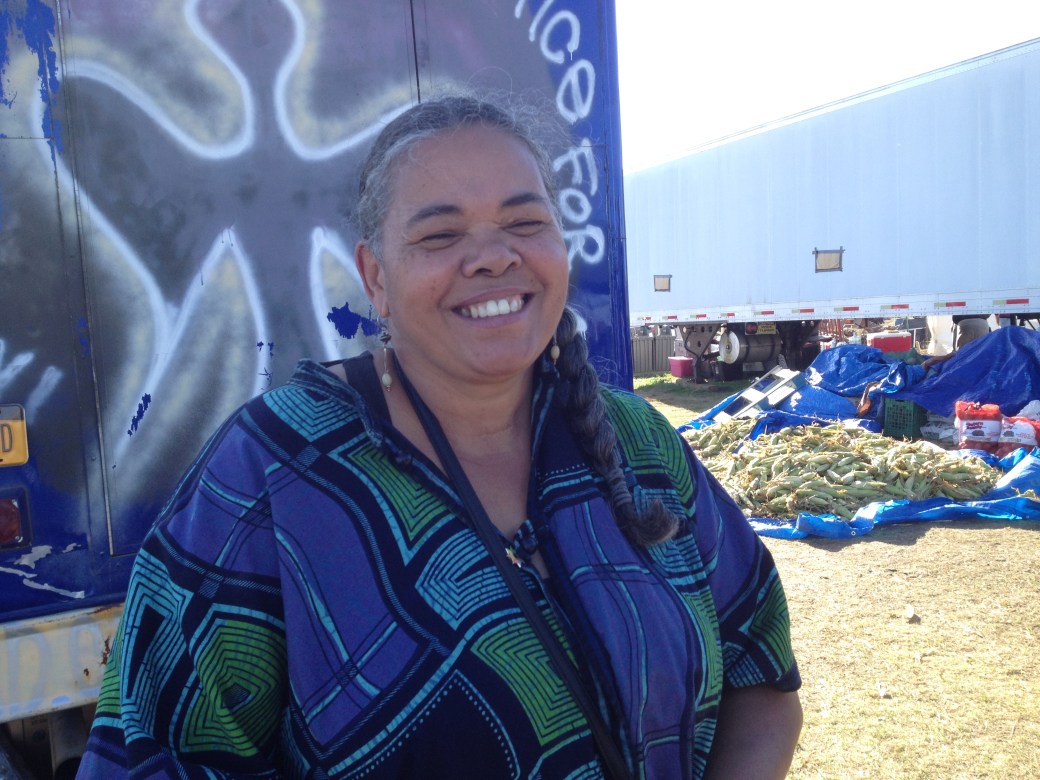
Audri Scott Williams
Lumbee/Cherokee/West African, Alabama
My name is Audri Scott Williams, and I’m a global trustee with the United Religions Initiative, which is an organization in 98 countries around the world. We have about 800 of what we call cooperation circles – grassroot groups. One of our primary objectives is to end religiously motivated violence by building bridges of peace and justice. And when we say religions, we’re talking about every religion – every form of indigenous spirituality, no exceptions. We figure that if we can make it happen on that level, we can be so far-reaching. So we came here to read a letter from the organization in support of what’s happening here at Standing Rock, in terms of preserving our environment and protecting the sacred waters of life.
I’ve walked around the world, on all six continents, and no matter where it was, especially in indigenous communities and poor communities, you see the impact of dumping and extractive industries. Most often, it’s occurring in places where there is no voice or a silenced voice. And so, here – I feel like this is a spark. And that flame is going out to all those communities, and raising them up, raising all of those voices up in a way that I haven’t seen done before, ever, in my lifetime.
I’ve been an organizer of indigenous programs for a long time – co-convener of the global indigenous network and a member of the indigenous science network. So I’ve traveled on this path for a long time. I’m of both African and Native American ancestry. And as I’m here I’m realizing that as I go back out to different places in the world, I get to bring this message with me. Even if I don’t speak it, it’s in me now – it’s in my presence. So that’s a reason for being here, too.
This is contagious. So many of us have been struggling – I mean, really struggling – to bring the environment, the water issues that galvanize the support of communities across the board, to the forefront. To somehow communicate that expediting the flow of oil and the proceeds and the profits isn’t the way to preserve Mother Earth. If we really want to do that we need to slow things down, to be clear about our intention and what we’re doing, what we’re supporting. To do what’s right for Mother Earth. Because never before have we stood so close to the edge, to the possibility that our children and grandchildren won’t even have a place to grow and to be nurtured and supported in this world.
When I say that, some people think I’m getting a little too extreme. But we’ve never had so much power in our hands as we do right now – the power to destroy the world in an instant. And from what I’ve seen on a global level, especially at a political level, there’s not the maturity to go along with that level of responsibility. So we as earth people, earth keepers, wisdom carriers, water protectors, indigenous folks – we have to rise together and put the spiritual essence back into this. To bring it all back into balance.
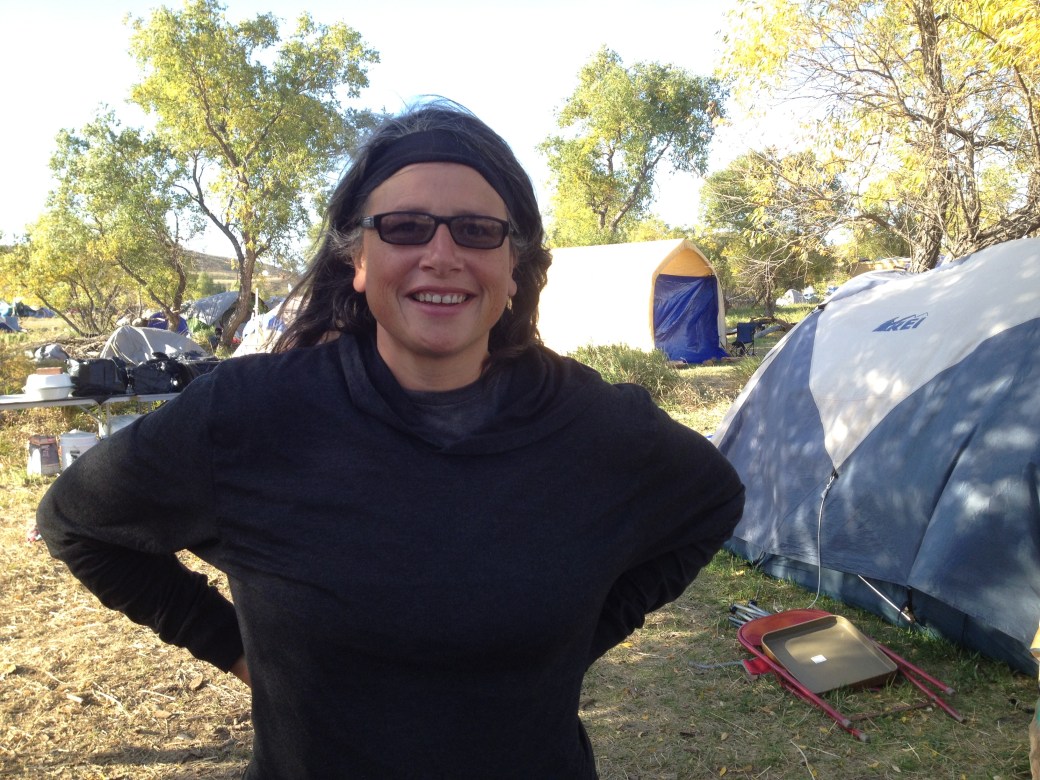
Chas Jewett
Cheyenne River Lakota, South Dakota
I’ve been working on environmental issues for twenty years now, and this is kind of the culmination of my career. I’ve been organizing Indians for a long time. I started out with the Sierra Club, but working with Indian people, trying to organize them. I was pretty involved with the Keystone pipeline, too, and this is really a continuation of that fight. A lot of the same people are here.
I’m here because I’m afraid that the planet’s going to be destroyed because of the fossil fuel industry, and I’m also here because it’s about time that we as tribal people were respected. That when we say no to something, it can mean no, instead of the authorities simply consulting us and then doing what they want to anyway, which is what they’ve been doing to us for 180 years. When they got us onto the reservations and they started assimilating us – we just wanted to go about our business and to be left alone. But we didn’t get to be left alone, because of all of the federal policies, and the shrinking of the reservations and other such actions.
Now, we’re at a point where we can’t leave things alone. We can’t stay isolated, because the fossil fuel industry and the military industrial folks are destroying the earth, destroying the fresh water; destroying the fact that we as a sovereign people have a right to fresh water. That’s part of our religion – you know, we’ve only been able to practice our religion since 1978. In 1978 they passed the Religious Freedom Act – for a country founded on religious liberty, it’s really funny that we’ve just been able to do that in my lifetime.
So a lot of this has been about prayer, and a lot of it has been led by the youth. The young people have never not been able to pray the way that our people do. So I think a lot of that energy and a lot of that power – that spiritual power – is coming from them. And I also think a lot of it’s coming from the ancestors. I think there’s a lot of unrest on the other side, and that they want us to fix things and do what we’re supposed to do. To heal ourselves, and to heal the earth.

Natalie Stites
Cheyenne River Lakota, South Dakota
For me this is a family issue. I came with a sister of mine through the making-of-relatives ceremony, a sacred ceremony. When we started seeing the armed guards on social media, and the arrests, we were very concerned. After two days of arrests our sisters told us that there wasn’t any legal support or attorneys on the ground. I think at that time there had been about 13 arrests. I have a law degree and my friend is a licensed attorney. So while we were hesitant because both my sister and I have children – she’s in Denver and I’m in Rapid City – when we heard that they had no legal support we decided to drive out. We tried to do just an initial assessment of what we thought were legal issues at the time and what we thought would need to be addressed. I’m hoping that I’ll be able to respond efficiently should the Standing Rock Sioux Tribe and the Cheyenne River Sioux Tribe officially request support.
I feel like it’s a phenomenon. Talking to some of the professional activists that are here – and I am not a professional activist – they say that there’s really nothing comparable to what’s happening here. Maybe some of the stuff going on post-Katrina in the Gulf might be comparable. But the size of the protest and the way in which it’s being supported is just phenomenal and amazing, and I feel like that everybody has a role in trying to protect the water that supplies the two reservations. Really it’s not an exaggeration to say that if you eliminate somebody’s water supply or a people’s water supply, that you are enacting genocide against them. Everyone thinks the Holocaust was this horrifying incident – unprecedented – but there are never all of these red flags waving, letting you know: You’re going the wrong way here, you’re going the wrong way there. Instead, it’s this seeping thing that happens. And I hope that they remember their place in history when we look to the future. If this pipeline prevails – and it will break – see if their children can drink water, because ours won’t be able to, either.
There is a really simple, beautiful message here: Protect the water, and Come stand with us. Those two things carry a lot of weight, and are clearly important to a lot of people. The fact that so many people are here together and there’s very little violence – there’s very little conflict, or trash, even – it’s just amazing. Even in the face of the state violence that has upset everybody, we’re still managing to stay peaceful. I really do think that all professionals and all officials and all government employees and everybody who works for the various federal agencies have a duty to help to protect every single one of the people who are here making this stand.
I think it’s important for indigenous peoples to take the leadership on these issues, with the violence against Mother Earth, because it ends up playing out as violence against the people as well. Because of our ancestral knowledge and our philosophy as a whole, we have an understanding of what’s at stake, I think, in a way that other traditions do not. Particularly a tradition like the Western tradition which has created these extractive industries, and the greed and the hubris that’s normalized as though this is a normal way to be, a normal way to live, without any regard for the future.
As a Native American woman, as a Lakota woman, I know that nonviolent direct action isn’t necessarily a part of Lakota thought and philosophy, but I think it comes from its own proud tradition in the Western sense, and certainly we’ve been borrowing and using these type of methods. I don’t have any problem with the idea of being a protester. Martin Luther King was a protester. And I think it would serve us well to embrace that term. But I like protector as well – whatever people are comfortable with. And I feel like you can’t stop the people. You can’t stop the people from expressing themselves, from standing against the pipeline at this point. And then on the other side I’m like, well, you can stop the people by killing them and imprisoning them and cutting out their leadership – there are all of these different ways that they’re trying to stop the people.
The people out on the front lines and the protest sites – they’re taking the heat of it. But just camping here on this occupied territory – while the Army Corps has jurisdiction over this area, we as peoples never agreed to it. This is part of the original treaty boundaries of the Great Sioux Nation. If I could impart one thing it’s that while there may be multiple camps here, the biggest camp is a family camp. Just family and friends. That’s really what a tribe is, too – it’s a common kinship among people. So I think that we’re being perfectly consistent with our philosophy, despite being colonized.
All of this is a really amazing and emotional decolonization process for a lot of people – myself included. A lot of people are healing here. I know people who have lost loved ones and were facing a lot of depression and anxiety, and all those issues, and they’re here now, and they’re experiencing something that they haven’t experienced in so long. Friends of mine were saying that these might be the best days of our lives, something that we remember forever. I’m really glad to have my daughter here experiencing this. She’s young, but just impressing this upon her while her mind is developing will help insulate her for the future against what we face as women, as indigenous people.
I don’t know what the future holds, and this standoff – I just want it to end peacefully; I want it to end with accountability. I want the state of North Dakota to be held accountable for its criminal conspiracy with Dakota Access to not just oppose us or not just have an actual negotiation or consultation or consent-type solution – they’re trying to just destroy and annihilate any type of opposition to anything that they’re doing. Those sacred sites that were plowed – that was really demoralizing for a lot of people. So there’s this psychological component – the helicopters constantly flying over us, we’re all on edge, anxious. This pipeline is over 60 percent complete from what I’ve heard, and best believe they’ve plowed up a lot of sacred sites and a lot of our graves along the way. As do all of these projects. And so it’s not just an isolated incident that’s happened – that’s their protocol.
But to say that this is just about Native Americans defending our treaty territory or to say that it’s just an indigenous issue, or that it’s defined by graves or sacred sites being plowed by this heavy machinery is only one part of the story. Because really, we’re doing this for all of humanity. And even for that North Dakota governor who’s disgusting, despicable, and the entire arm of his government that’s complying with this – we’re doing it for them, too, so that they have healthy water, and their descendants have healthy water, clean water – that they have any water at all. None of them can drink oil.
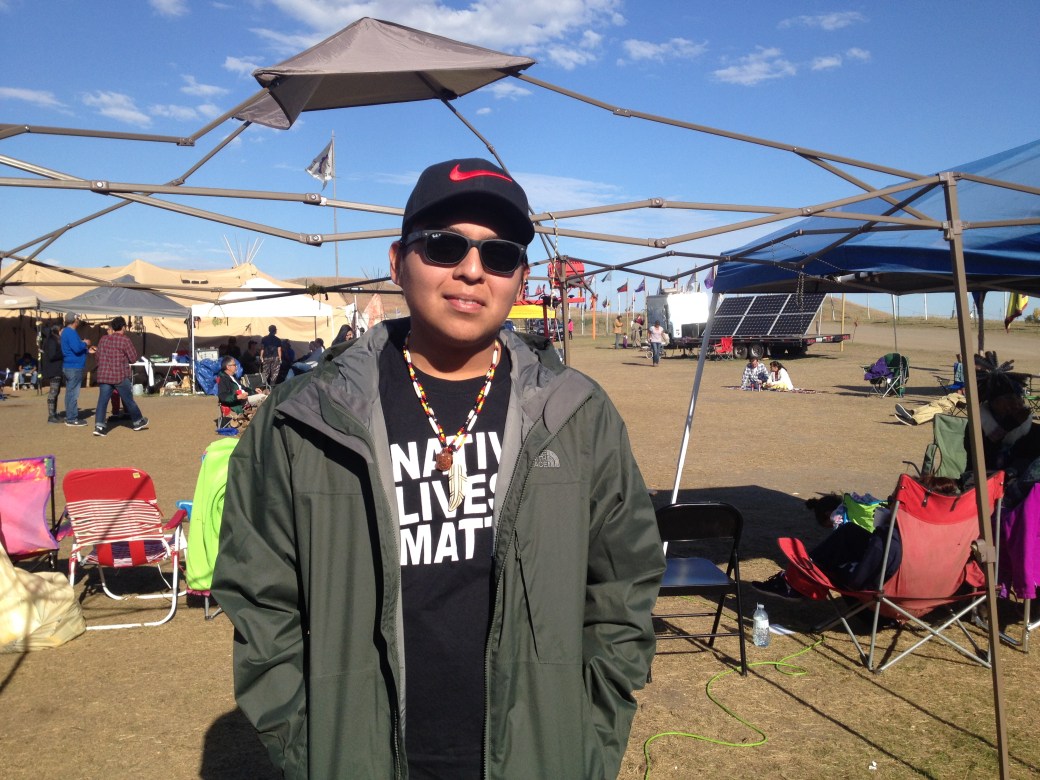
Eduardo Ocampo
Navajo/Mexican, Nevada
I felt the need to be out here. I’m originally from Vegas, so that’s probably a 1,200 mile drive. It took me 25 hours to get here. I’m half Navajo, half Mexican, but I embrace both cultures equally because I’m both bloods. Something just told me to come out here, and so I came.
I feel at home here – like I belong. I’m here to help protect this land, protect the water, because without the water none of us would be here. Seeing all of these people around me – everyone’s here for the same reason. And it’s amazing to see all of these nations and tribes gathering together. Probably the last time this happened was over 150 years ago. And we’re all doing it for one purpose, and it’s water. That’s the reason why I’m out here.
People that have seen us in the news, they’ve seen us portrayed us as savages, like always – which isn’t true. They say we have weapons, and we’re unarmed. We’re peaceful protesters just protesting for our water. That’s all we’re doing.
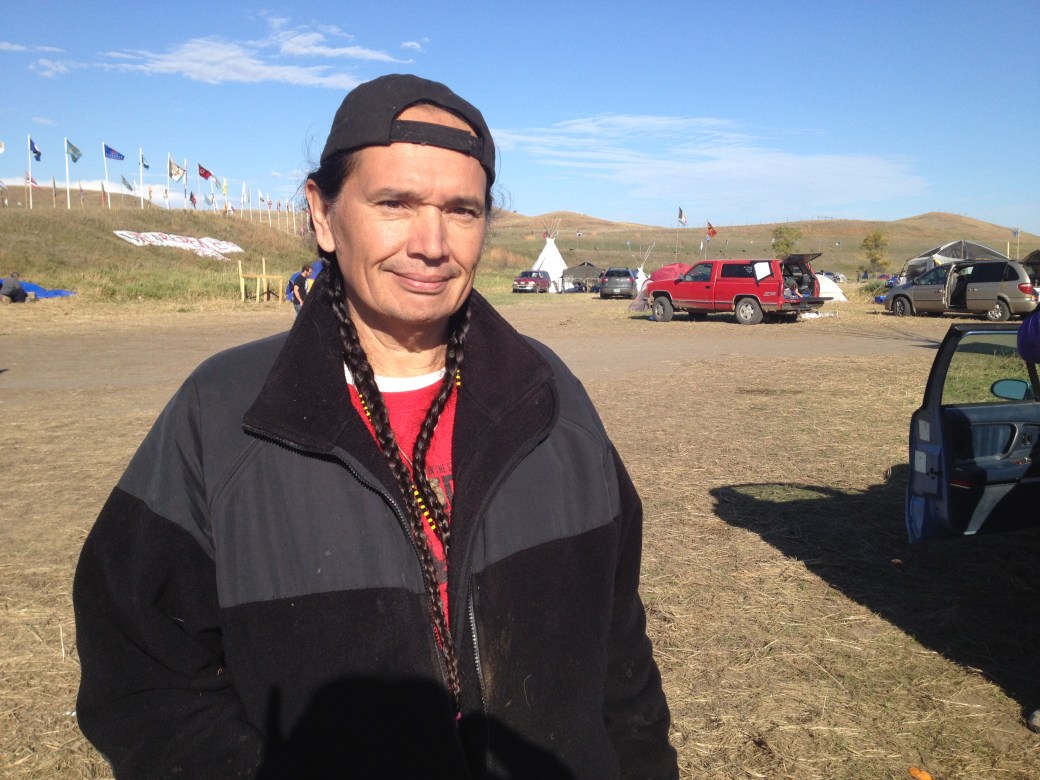
David Claymore
Cheyenne River Lakota, South Dakota
The people have been suffering for a long time. It’s just the second coming of Custer – they think they can run over us all the time. And they’ve done it in the past, and they’re still working on doing it today. It’s hard to watch – you know, the people are going to be suffering because of the oil spills. In Alabama last week an oil line broke, I was watching that on the news before I came up here. I’ve heard the crews say, “Oh, they’re made the best way possible.” But there are still spills, so it’s just a matter of time. It might not be me, but my grandchildren, who will have to suffer because of the pipeline.
Watching everybody here – it’s amazing. I’ve heard people say that once you get here you won’t want to leave. And as a Sundancer, that’s the way you feel when you’re getting toward the end of the Sundance. I mean, you’ve been suffering for days, and then all of a sudden at the end of the Sundance, it’s like, can we do that for four more days? You want to stay even longer. And that’s how it feels here, because we were supposed to leave today, and now we’re leaving Tuesday. Because of that feeling, because of the camaraderie of everyone working together, helping each other. Sure, there are a few problems here and there, but that just comes with being a family. Last night we had to look for a little child that was missing. And everyone just turned into this big search crew – you know, just going all over camp and calling the little girl’s name and everyone had their flashlights, everybody turned their car lights on. So all of a sudden it was just this huge search and rescue for this little girl, and eventually they did find her and she was all right. It’s like the camp is just bringing the whole world together, and it’s amazing. We’ve even brought all the tribes together, to where they’re working together today to help each other and help Standing Rock. It’s amazing because the Lakotas weren’t even together in the sense that we are now. That’s something that hasn’t been done since way back in the late 1800s.
I’m from this reservation, and my grandpa is Chief Gall. He was on this reservation in the beginning, and then Sitting Bull came back from Canada and he stayed. There’s a French fur trapper on my Dad’s side, one who came and married a Lakota woman, but I found out that Chief Gall and one of my Claymore grandfathers were best friends. And they both spoke Lakota – the Claymore, he could only say “yes” in English. And here I am today, struggling myself because my Mom didn’t teach me how to speak Lakota because of the boarding schools. She can understand, from her Mom and Dad, but my Dad never really knew too much. And then my Dad’s side of the family were the adapters – they were the ranchers, they were the farmers, and they didn’t really want to be Lakota. Same with my Mom – she was kind of just existing. But my adopted Dad told me, “If you don’t know your culture, if you don’t know your language, then you’re just a brown American. You’re not a Lakota.” So I took that on, and I had this deep-felt desire to be Lakota.
When my Mom and Dad grew up – and when we started the first Sundance in ‘68 – it was against the law to be Lakota. You couldn’t pray in your language, they washed your mouth out with soap; they whipped you and punished you for being Lakota. They said, “Kill the Indian, Save the man.” That was their motto back then. So even my Mom, even though her Mom and Dad spoke Lakota to her all the time, and I was a little boy running around playing and I’d come in and listen to them talking to her, after they left I’d come back in and I’d say, “Mom, how come Grandma and Grandpa talk funny?” I didn’t even know what it was. And she would say, “Oh, they’re just talking Indian.” She never went beyond that. And so there I was, this young man, young boy, having a desire deep inside, this instinct, to be Lakota. When I was 10 years old, I even asked my Mom, “How much Indian would my children be if I married a full blood?” Because my Mom was 3/4, my Dad was 1/2, so then that made me 5/8, a fraction. The white man did that to us – fractioned us out. So when I asked her that she was like, “Fractions, I don’t know, go ask your Dad.” So then I did, and I found out that my children would be 13/16. Which – you know, they’re more Indian than I am because I married a full blood.
My wife and have been together since she was 12 and I was 14, and now we’re 52 and 53. And we’ve got four children, we’ve got five grandchildren, but we met, and then just hit it off and stayed together. And we’re both very cultural, very spiritual. This is my grandson. He’s four years old, and he’s got his own drum – the spirits told us to get him ready, because he’s going to have an altar to help and doctor the people. And he’s only four years old. So we’ve been teaching him – he sings, he prays, and he knows his culture. And he hasn’t even gone to school yet. So we’re busy instilling in our little ones to be Lakota. People today, they still don’t know quite how to nurture a spiritual youth. We have to remember – they’re spiritual beings. I sat at the fire last night talking to some 18-year-olds, 21-year-olds, 25-year-olds – they were starving for knowledge. I ended up sitting up with them until 6 a.m. this morning, visiting with them, teaching them and telling the stories. And they were just all absorbing it.
As a human being, everyone comes across difficulties – death, and depression, and all of these different problems. And we use the ceremonies to overcome them. I have years of experience doing these ceremonies. The White Buffalo Calf Woman brought us seven ceremonies. It would be like the Christians’ Ten Commandments. So I learned the seven rites in my early 20s. I told my father-in-law, “Hey I’ve been through the seven ceremonies, and I’m just excited. How do you keep that good feeling alive?” And he said, “Just keep doing the ceremonies!” So I’ve been doing them ever since.
Even as a young person, when I was very active in alcohol and drugs, I listened to this Sundancer – he had a dream that if you pray to this Blue Eagle, to this spirit, and ask for help with alcohol, drugs, or anything like that – addiction – this Blue Eagle would help you. This Blue Eagle said, “Make me seven blue tobacco ties, and I’ll help you. And if your relatives are sick and suffering with that disease, I’ll help them.” This was in the 80s. So I prayed for my Mom and Dad, and they both sobered up. My Mom died 28 years sober, and my Dad died 11 years sober. Then I sobered up a few years later, in ‘92, and now I’ve been sober 23 years, alcohol and drug free, using this spirit – Blue Eagle.
At that time when I heard about this guy having this vision, they put me on a vision quest – a Hamblecha, they call it. And I had a vision – the spirit came to me and gave me the name Blue Eagle. So here I am, 23 years later, sober, using this spirit’s help, and then also going to treatment and learning about the addiction and why I have it. So now I’m busy teaching those that are suffering with that, too, by spreading this vision and this word that you can get help spiritually. And you can go and get help at a treatment center. Everybody’s scared of the word “treatment.” Shoot, you break your leg, you’ve got to go get it set. You got to get a cast, you’ve got to get it treated. But the spiritual bankruptcy that alcoholics feel, they feel: Wow, I don’t want to go to treatment, that’s something bad. And it’s not, but in their mind, it is. I had the same feelings when I first thought about going in – that it’s not good. But over time, it is. So it takes an addict some time just to get over that little bit of fear. Everybody hates change. And even when you’re changing to be something good, you’re still scared and still don’t want to do it because it’s unknown. You don’t know what the outcome’s going to be. But once you get on the other side of that feeling, you realize that you should have done it a long time ago. I run across that a lot – people who have that same fear I did.
Right now we just came back from a Grand Opening of a sculpture that’s 50 feet high, a Lakota woman, with a star quilt on her back. I designed the star quilt. And I was working with the sculptor, we’ve known him 30 years, and he did two sculptures of our oldest daughter, which are in Rapid City. So we’ve known him 30 years or so, and we had a sweat lodge on his land for quite a while. So we’re going back and forth with this Dignity sculpture and working on the star quilt, and all of a sudden he was like, “Sydney (my wife), you’re a full blood aren’t you?” And he said, “Well, you know the first woman that I did, she was Lakota, but she’s part German and Hispanic, so her features aren’t a true Lakota. So would you mind sitting for me to do this face?” So Sydney said, “Sure,” and we got to go down and do the opening with Sydney’s face 50 feet in the air, and my star quilt on the back. And then the sculpture’s name is “Dignity.” When Lewis & Clark came – the Missouri river, where the sculpture is? There’s a rest area, Lewis & Clark rest area. So then a reporter asked me, “How do you feel about that Dignity sculpture going where Lewis & Clark came up the river?” I said, “Well, if you talk to our elders, that was the first disturbance of our culture and our way of life, when they came up that river. So then that’s the best place to put it because, seven generations after Lewis & Clark, they say, our whole life was disrupted.” Totally chaotic, and people didn’t know how to be. So now they’ve adapted, and they’ve become doctors, and lawyers, and nurses, and mechanics – and all this different educational teaching, so now it’s flipped over seven generations later to where we are in that prosperity. We’re picking ourselves up off the ground. And now we’re becoming – we’re getting our dignity back, as Lakota people. So now we have the strength and the courage to be, as you say, Wakan Tanka, Tunkashila or God – who they intended us to be. We weren’t supposed to be alcoholic drug addicts and abusive to our own people. That was put on us. So now we’re becoming sober and living a better life than they ever expected us to live. They wanted to get rid of us – genocide. They wanted to kill us all off, just like the buffalo. And the buffalo came back from just a very few. The people say that they were praying 100 years ago for us. And here it is 100 years later, you’ve got all these buffalo ranches, the buffalo being raised by Indian tribes all over the country – there are over 46 tribes raising buffalo. And then you’ve got the eagle off the endangered species list, and you’ve got the Lakota off the endangered species list. So here we are, coming back – and then they want to run oil through our water. And they’re like, “Well, the farmers and ranchers didn’t want it where we were going to put it – let’s go put it through the Indians’ land, they don’t care.” And so they made an attempt, and we’re attempting to stop it. And we’re just going to keep working on it and working on it until we get it done.
There’s my other grandson – his name is Cassius Claymore, like Cassius Clay. I keep telling everybody, “When he gets older we’re going to rename him Muhammad Ali Claymore – Muhammad Alimore.” His Lakota name is Iya Galeshka, which means “Spotted Stone.” And he talks to the stones, those little round stones. You can find them in the earth all over, from the meteors – they just form because they’re coming down so fast and hot that they just stay round. This guy, he talks to them, and we have to nurture that in him so that he can use those stones to help the people. If I give him one, he’ll sit there and whisper to it, and then he’ll put it to his ear like he’s listening and responding and then he’ll say something else. If you told a psychologist or a psychiatrist, they would say, “Oh, schizophrenia.” Right away they’ve got to demean them for having something that the psychiatrist doesn’t have. They’re educated severely, yet they can’t talk to a stone. So then the kids have got to be bad, and it’s got to be wicked or witchcraft, or some kind of craziness. Whereas – Shoot, that’s the way the people are.
There was a really good statement made in the movie “Greyeagle,” where kind of the bad Indian guy was feeling bad about the way the situation was for the Indian people. He said, “The wolves won’t even talk to us anymore. Having contact with the white people has dirtied us up to where the wolves don’t even respect us anymore.” And you know, being able to communicate with the spirits, being able to communicate with the stone, the earth, the plants – all of those things is one of our abilities. And if you look back far enough in European history, they had the same tools. I mean, they could do the same thing, but they didn’t want the people to follow their traditional ways, they wanted them to follow the Bible, and Jesus – Christianity. So then they killed a whole bunch of their own people, to shut them up and get rid of them so that they could follow the Bible. And it’s just crazy that they would go around killing their own people just to control them. So it’s a sad deal that happened to them. So they’re coming to us, asking us for help – How do we get connected? There’s another movie, “Dreamkeeper,” where the young guy’s mad, saying, “Oh these white people, they’re all wannabes. They all want to be Lakota.” And the old man says, “No, it wasn’t them that took our land. It wasn’t them that took our buffalo, it was their ancestors. And if they’d seen them today saying they want to be Indian – they’d turn over in their graves. Yet you call them wannabes,” he said – “they want to be connected. Just like us. They’ve lost their way.”
So now, they’re coming from all over the world. I deal with Japanese, and Chinese, and Australians, and Germans and French. And I keep telling them, see, you dig deep enough in your own cultures, you’re going to find the same things that we have here. It’s just that we’ve been disrupted for the last 150 years. You’ve had thousands of years of disruption. So if you look back far enough you’re going to find the same things you find here. You’ve just got to dig a little deeper. And then they all want to be medicine men, they all want to be medicine women, you know, and it’s like – go find your own culture, and use that to help your people. Use us as a catapult, or whatever you want to call it, to get involved in doing that for yourself, for your own people. We’ll help you, we’ll show you, we’ll teach you.
My father-in-law was a really giving traditional man. He was born in 1919, so his parents, his grandparents, were free people, before the reservation lifestyle. So they were very generous. Some of the people today, they have their medicine, or their power, and they’ll let you peek at it. You know, “Check it out – look what I’ve got.” And they’ll let you kind of get a glimpse of it – but no, it’s mine. I’m the medicine man, I’m the powerful one here. But my father-in-law would say, “No, you give it away. It doesn’t belong to an individual, it belongs to the people.” So he would teach anybody. That’s where I learned that.
You know, we’ve got to nurture the whole planet. We’ve got to get us all back to living in a spiritual way – a true spiritual way. Because you can have faith, and you can have belief, but those are sissy words, my father-in-law would say. Because once you learn the truth – then you’re going to stay with the truth, because that doesn’t waver. Your faith can change, your belief can change. But once you learn that this is the truth, then you’re not going to falter, you’re not going to sway, because now you know the truth. That this is a powerful way of life, and this is a connection that can’t be changed or maneuvered. So then that’s going to help you to live your life better, and you’re going to teach your children better, and you’re going to teach your grandchildren. And there are great-grandchildren now that are coming, that we have to prepare for. Lakotas always say, seven generations ahead, you’ve got to think about them. And take care of them. That’s why it’s important for this oil not to be continued.
And they’ll probably end up going around or doing whatever they do, because that’s the way they are. And the Almighty Dollar, they say, is what’s prompting them. I mean, they’ve got security guards hired with dogs biting people. That’s how far they’re willing to go to dampen our spirits. But it’s just fired everybody back up again. It’s like, “How dare you sic your dogs on us?” So we just keep praying and everything seems to be falling into place. It’s just a matter of time, and it’s all going to work out.
